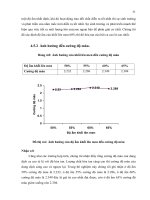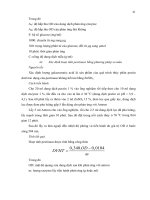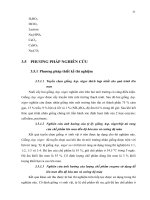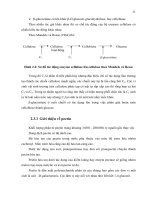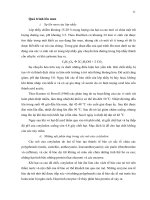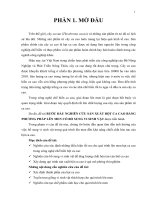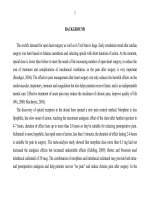nghiên cứu tác dụng giảm đau bằng phương pháp tiêm morphin có hoặc không kết hợp với sufentanil vào khoang dưới nhện trên bệnh nhân mổ tim hở bản tóm tắt tiếng anh
Bạn đang xem bản rút gọn của tài liệu. Xem và tải ngay bản đầy đủ của tài liệu tại đây (266.24 KB, 35 trang )
BACKGROUND
The world's demand for open heart surgery as well as in Viet Nam is huge. Early extubation trend after cardiac
surgery was born based on balance anesthesia and selecting opioid with short duration of action. At the moment,
opioid dose is lower than before to meet the needs of the increasing number of open-heart surgery, to reduce the
cost of treatment and complications of mechanical ventilation, so the pain after surgery is very important
(Roediger, 2004). The effective pain management after heart surgery not only reduces the harmful effects on the
cardiovascular, respiratory, immune and coagulation but also helps patients recover faster, and is an indispensable
mental care. Effective treatment of acute pain may reduce the incidence of chronic pain, improve quality of life
(Wu, 2000; MacIntyre, 2010).
The discovery of opioid receptors in the dorsal horn opened a new pain control method. Morphine is less
lipophilic, has slow onset of action, reaching the maximum analgesic effect of the chest after lumbar injection in
4-7 hours, duration of effect lasts up to more than 24 hours so they're suitable for reducing postoperative pain.
Sufentanil is more lipophilic, has rapid onset of action, less than 5 minutes, the duration of effect lasting 2-6 hours
is suitable for pain in surgery. The meta-analysis study showed that morphine dose more than 0.3 mg had not
increased the analgesic effects but increased undesirable effects (Gehling, 2009). Bettex and Swenson used
intrathecal sufentanil of 50 mcg. The combination of morphine and intrathecal sufentanil may provide both intra-
and postoperative analgesia and help patients recover "no pain" and reduce chronic pain after surgery. In the
1
world, there are few studies with limited objects, no study has been done on this issue in Viet Nam. We conducted
this study with the following objectives:
2
1. To compare the intraoperative analgesia of single intrathecal morphine dose of 0.3 mg, intrathecal morphine
0.3 mg combined without or with sufentanil doses of 25 mcg or 35 mcg dose before induction in patients
receiving general anesthesia for open heart surgery.
2. To compare postoperative analgesia of the above methods.
3. To assess the effects on respiration and some undesirable effects of the methods above.
THE NEW FINDINGS OF THE THESIS
- Intrathecal sufentanil attenuates intraoperative fluctuations of mean blood pressure and heart rate, reduces
significantly intraoperative intravenous sufentanil consumption and the intrathecal sufentanil dose of 25 microgram
is appropriate to reduce pain during open heart surgery.
- The intrathecal morphine dose of 0.3 mg combined with or without sufentanil reduces postoperative pain,
manifested by the decrease in morphine consumption during the first 30 hours, VAS at rest during the first 16 hours and
VAS at deep breath after extubation. At this dose of intrathecal morphine, no changes in FEV1 and FVC, in the
undesirable effects, in the duration of mechanical ventilation and extubation time are found.
- The combination of intrathecal morphine and sufentanil before induction in open heart surgery provides
effective analgesia per and post-operatively.
Layout of the thesis: The thesis has 117 pages
Background 2 pages
Chapter 1. Overview 35 pages
Chapter 2. Subjects and Methods 16 pages
3
Chapter 3. Results 26 pages
Chapter 4. Discussion 36 pages
Conclusions 1 page
Recommendation 1 page
References: 169 (16 Vietnamese, 136 English, 17 French).
CHAPTER 1
OVERVIEW
1.1. Postoperative pain affects the body
1.1.1. Factors affecting postoperative pain
Surgery is the main factor to decide the importance and duration of postoperative pain. Thoracic and big
abdominal surgeries are the most painful. In addition to surgical factors, cultural factors, the threshold of pain,
previous pain experience, the emotional, cognitive, situations, behaviors and attitudes, age and gender also
affect the nociception (Serrie, 2002).
1.1.2. The impact of pain during and after surgery on the body
Trauma caused by the surgery causes neuroendocrine response, a combination of the local inflammatory
response (due to cytokine and leukotriene) and neuroendocrine metabolic factors causes catabolisme, increase in
catabolic hormones such as catecholamines, cortisol, renin, aldosterone and glucagon, decrease in anabolic
hormones such as insulin and testosterone. On the way to the cortex, pain impulses going to the hypothalamus
4
trigger the behavior, emotion, mood changes and general feeling such as anxiety, sleep disorders. When pain lasts
longer than normal may cause depression. Postoperative pain if not treated effectively is the risk of chronic pain,
affecting the quality of life (Wu, 2002).
Activation of the sympathetic nervous system in response stress or inadequate analgesia may cause heart
rate, myocardial contractility increase and hypertension leading to increased myocardial oxygen consumption,
loss oxygen demand - supply balance, leading to an increased risk of myocardial ischemia or infarction that this
phenomenon peaks in the postoperative period.
Influence on respiratory function occurs in the first 24 hours following surgery and returns to the preoperative
values in 2 weeks thoracic or big abdominal surgery. Reduction is to 40% vital capacity after upper abdominal
surgery. Besides, There is postoperative increased coagulation status, immunosuppression and gastrointestinal
disorders.
1.2. Pain assessment
1.2.1. Intraoperative pain assessment
Analgesia (pain relief) amnesia (loss of memory) and immobilisation are the three major components of
anaesthesia. The perception of pain, and the need for analgesia are individual, and the monitoring of analgesia
is indirect and, in essence, of the moment. Under general anaesthesia, analgesia is continually influenced by
external stimuli and the administration of analgesic drugs, and cannot be really separated from anaesthesia: the
interaction between analgesia and anaesthesia is
5
inescapable. There is no stool or method to directly mesure intraoperative pain.
Autonomic reactions, such as tachycardia, hypertension, sweating and lacrimation, although non-specific,
having been proposed by Evans, using the PRST (blood Pressure, heart Rate, Sweating, Tears) score of
responsiveness are always regarded as signs of nociception or inadequate analgesia.
The authors used this score to assess intraoperative pain in their studies (Stomberg 2001; Turker, 2005;
Guignard, 2006).
1.2.2. Postoperative pain assessment
There are numerous scales to to assess postoperative pain. Currently, there are three types of scale used
clinically to assess postoperative pain (Viel, 2007).
Visual Analogue Scale (VAS): VAS is a reference scale in assessing the degree of pain and the effectiveness
of the treatment
Verbal Numeric Rating Scale (VNRS): Scale consists of a sequence of numbers, 0 corresponding to "no
pain" and 10 being "unbearable pain". Patients were asked to evaluate and reply with the number corresponding
to their level of pain. This assessment may not need tools. VNRS scale is suitable for elderly patients.
Categorical rating Scale (CRS): This scale consists of five numbers in ascending order of intensity of pain,
each number corresponding to a description; 0 - no pain, 1 - mild, 2 - moderate, 3 - severe, 4 - unbearable pain.
This method is a quick, simple, low rate of incorrect response. This method is especially suitable for patients
unable to use VNRS or VAS scale (children and elderly).
6
The authors divide the pain intensity into three degrees: low, VAS ≤ 3 cm, moderate, VAS 3 - 7 cm and
severe VAS > 7 cm.
At the recovery room, patients with limited oral expression, the VAS is the appropriate scale to assess pain
and evaluate treatment response and morphine is used if VAS ≥ 4 cm. VAS score ≤ 3 cm at rest and ≤ 5 cm at
movement are defined as effective pain relief.
1.3. Intrathecal opioid for pain management after cardiac surgery
1.3.1. Pain in cardiac surgery
In cardiac surgery, the pain is caused by skin incision in the chest, sternotomy, field extension, the
mediastinal dissection, vascular canuyn, the subxiphoid drain and blood in pleural cavity. This painful stimuli are
conveyed mainly by the intercostal nerves from T1 to T11, innervating the chest wall, by diaphragmatic
innervating diaphragmatic pleura and by X nerve innervating mediastinal pleura. In addition, the cutaneous
branches from the cervical superficial plexus coming down to innervate skin upper part of the chest wall (Morgan,
2005). The neural axial (spinal, epidural) and paravertebral techniques may not affect the diaphragmatic nerve, the
vagus nerve, which is also the basis for the application of multimodal analgesic method after thoraco-cardiac
surgery.
1.3.2. Intrathecal opioid analgesia
Table 1.5. Pharmacodynamic parameters of intrathecal morphine and sufentanil
7
Drugs
Time
Sufentanil Morphine
Onset < 5 min 1 - 3 hours
Peak action < 30 min 4 - 7 hours
Duration 2 - 6 hours 20,5 - 40 hours
1.3.3. Intrathecal opioid analgesia studies in cardiac surgery
In 1979, Wang reported the effect of intrathecal morphine in postoperative and cancer analgesia.
Mathews and Abrahams were the first ones who applied intrathecal morphine on the heart surgery patients.
The studies before 1990’s used high-dose intrathecal morphine. When early extubation was applied in
cardiac surgery, the authors have used lower doses of intrathecal morphine so as not to prolong the duration of
mechanical ventilation after surgery, the authors used doses from 6 - 10 mcg/kg or 0.5 mg (Jacobsohn, 2006;
Roediger, 2006; Yapici, 2008).
The recent meta-analysis studies recommended dose of intrathecal morphine ≤ 0.3 mg to reduce undesirable
effects.
In Vietnam, the study by Nguyen Phu Van combined 7 mcg/kg morphine with 1.5 mcg/kg fentanyl
intrathecally, Nguyen Van Minh, morphine 0.3 mg combined with sufentanil before induction for open heart
surgery shows the effective pain relief. Some authors used intrathecal sufentanil dose of 50 mcg. The randomized
prospective studies on combination of morphine and intrathecal sufentanil are needed.
8
CHAPTER 2
SUBJECTS AND METHODS
2.1. Subjects
2.1.1. Selection criteria: Patients were planned open heart surgery to repair or replace valves, to repair
congenital abnormalities; Early extubation prediction; Aged 18 - 60; ASA II - III; NYHA I - III; agree to
participate in research; No allergy to opioids.
2.1.2. Exclusion criteria: Patients with chronic diseases such as chronic lung diseases, liver failure, kidney
failure, systolic pulmonary artery pressure > 70 mmHg; previous heart surgery; history of addiction or opioid
dependence, taking pain medication before surgery; abnormal spinal anatomy; Local infection or sepsis at the
site of lumbar punctur; left ventricular ejection fraction (LVEF) < 50%; history of abnormal bleeding
prothrombin ratio < 70%, bleeding disorders, platelet count <100 x 109/l; EuroScore ≥ 6 points.
2.1.3. Removed from the study criteria: More than 3 attempts at needle insertion; Bleeding during insertions;
Complications of anesthesia, surgery; Ventilation over 24 hours due to other causes such as heart failure, low
cardiac output or the intra-aortic balloon counterpulsation; the renal replacement therapy after surgery.
2.2. Methods
2.2.1. Study Design
9
Prospective, clinical intervention, single-blind, randomized study was conducted in the Department of
thoraco-cardiovascular Anesthesiology, Cardiovascular Center, Hue Central Hospital
From 01/2010 to 07/2012.
2.2.2. The sample size
Applying the formula for calculating the sample size, we selected a group of 40 patients.
Group 1 - control group, did not use intrathecal opioids
Group 2: Group injected intrathecal morphine 0.3 mg
Group 3: intrathecal morphine 0.3 mg plus sufentanil 25 mcg
Group 4: intrathecal morphine 0.3 mg plus sufentanil 35 mcg.
2.2.3. The main criteria for assessment
2.2.3.1. Intraoperative analgesia: Intravenous sufentanil consumption; Intraoperative hemodynamic stability:
Mean blood pressure, heart rate changes at intubation and the most painful time in surgery, the percentage of
patients with mean blood pressure and heart rate increase.
2.2.3.2. Postoperative analgesia: Postoperative intravenous morphine consumption by PCA; Visual analogue
scale (VAS) during the first 3 days after surgery at rest and at deep breath; FVC, FEV1; Hemodynamic
stability: Mean blood pressure, heart rate after extubation and during the first 3 days.
10
2.2.3.3. The effects on respiration and undesirable effects: Duration of mechanical ventilation and extubation
time; Respiratory rate, SpO2 and blood gases after extubation and the first day after surgery; Respiratory rate,
SpO2 in the first 3 days after surgery (oxygen via nasal inhalation of 4 l/min); Undesirable effects: Sedation,
nausea, vomiting, pruritus, urinary retention, respiratory depression, epidural hematoma.
2.2.4. Procedure: Selecting randomly the patients to the group, setting up monitoring, inserting spinal needle 27 G
(B/braun company) (groups 2, 3, 4), using medications, depending on the group. Anesthesia, cardiopulmonary
bypass and postoperative care follow the same protocol in the four groups.
CHAPTER 3
RESULTS
Data processing of 160 patients with open heart surgery, the following results are obtained.
3.1. Anesthesia and surgery characteristics
3.1.1. General characteristics
Age, height, weight average and male/female ratio of the four study groups did not differ significantly (p >
0.05), the lowest age is 18 and the oldest 59 years old. Average weight was 49.4 ± 6.8 kg (p > 0.05), women in
each group dominated.
11
3.1.2. Anesthesia, cardiopulmonary bypass, surgery characteristics: early extubation anesthesia applied by
etomidate, sufentanil, vecuronium, isofluran, and propofol during cardiopulmonary bypass. Patients undergoing
valve replacement or repair surgery accounted for about 70% of patients in the group. The rest was atrial and
ventricular septal closure.
3.2. Intraoperative analgesia
3.2.1. Intraoperative sufentanil consumption and anesthesia time
*, † p < 0,05: Versus group 1 and 2
Figure 3.1. Intraoperative sufentanil consumption and anesthesia time
12
†
*
Anesthesia time did not differ significantly between the groups, the amount of intravenous sufentanil used in
surgery in group 1 and 2 higher groups 3 and 4 in a statistically significant manner (p < 0.05), butno statistically
significant difference between groups 1, 2 and 3, 4.
3.2.2. Intraoperative mean blood pressure and heart rate stability
13
†*
* p < 0,05: Group 3 versus group 1, 2;
† p < 0,05: Group 4 versus group 1, 2
Graph 3.1. Mean blood pressure at different surgical time
Mean blood pressure at skin incision in group intrathecal sufentanil (group 3 and 4) was lower than the
group without sufentanil (group 1 and 2) (p < 0.05).
Table 3.12. Patients with mean blood pressure increase
Group
Time
Group 1
(n = 40)
Group 2
(n = 40)
Group 3
(n = 40)
Group 4
(n = 40)
p
Postintubation 32,5% 30% 22,5% 25% > 0,05
Post incision 55% 52,5% 25%* 27,5%† < 0,05
Poststernotomy 17,5% 15% 10% 7,5% > 0,05
*, † p < 0,05: Versus group 1, 2
14
The percentage of patients with mean blood pressure increase after incision in intrathecal sufentanil groups
(groups 3, 4) was significantly lower than in no sufentanil groups (group 1, 2) (p < 0.05).
* p < 0,05: Group 3 versus group 1, 2;
† p < 0,05: Group 4 versus group 1, 2
Graph 3.2. Heart rate at the most painful time points
Heart rate at skin incision in group intrathecal sufentanil (group 3, 4) was lower than the group without
sufentanil (group 1, 2) (p < 0.05).
15
†*
Table 3.14. The percentage of patients with heart rate increase
Group
Time
Group 1
(n = 40)
Group 2
(n = 40)
Group 3
(n = 40)
Group 4
(n = 40)
P
Postintubation 22,5% 20% 12,5% 15% > 0,05
Post incision 35%* 32,5%) 15% 12,5% < 0,05
Poststernotomy 17,5% 12,5% 15% 10% > 0,05
* p < 0,05: Group 1 versus group 3 and 4
† p < 0,05: Group 2 versus group 3 and 4
The percentage of patients with heart rate increase after skin incision in intrathecal sufentanil groups ( 3, 4)
was lower than in no sufentanil groups (1, 2) in a statistically significant manner (p <0,05).
3.3. Postoperative analgesia
3.3.1. Postoperative morphine consumption
16
* p < 0,05: Versus group 2, 3 and 4
† p < 0,05: Versus group 3 and 4
*
*
*
*
*
*
*
Figure 3.4. Postoperative cumulative morphine consumption
High postoperative morphine group 1 than group 2, 3, 4 at all time points evaluated statistically
significant (p < 0.05). The amount of morphine in the second group higher in the first 4 hours of group 3 and
group 4 was statistically significant (p < 0.05).
Table 3.16. Intravenous morphine consumption (mg) day 1, 2, 3
Group
Intervals
Group 1
(n = 40)
Group 2
(n = 40)
Group 3
(n = 40)
Group 4
(n = 40)
P
24 hours 20,6
±
9,2
*
8,5
±
6,5 6,3
±
4,1 5,8
±
4,8 < 0,05
24 - 48 hour 10,6
±
5,1
*
7,9
±
6,3 7,0
±
3,2 7,6
±
4,1 < 0,05
48 - 72 hour 6,2
±
2,9 6,4
±
4,9 5,9
±
3,5 5,5
±
2,8 > 0,05
72 hours 37,8
±
12,5
*
22,9
±
11,5 19,7
±
5,2 19,6
±
7,6 < 0,05
* p < 0,05: Versus group 2, 3 and 4
17
*
*
†
Intravenous morphine consumption on the first and second day in group 1 was significantly higher than in group
2, 3 and 4 (p < 0.05), morphine consumption on the first day in group 2 higher than group3 and group 4, but the
difference was not statistically significant (p > 0.05).
* p < 0,05: Versus group 2, 3 and 4
Figure 3.6. Postoperative morphine consumption at different intervals
Morphine consumption in group 1 was significantly higher than group 2, 3 and 4 in the interval of 24 - 30
hours (p < 0.05). Morphine consumption in the intervals 30 - 36, 36 - 42, 42 - 48 hours between groups did not
differ statistically significantly (p> 0.05).
18
*
*
3.3.2. Visual Analogue Scale
Table 3.18. VAS at rest
Group
Time
Group 1
(n = 40)
Group 2
(n = 40)
Group 3
(n = 40)
Group 4
(n = 40)
p
H4 3,80
±
1,11* 2,28
±
0,75 2,20
±
0,74 2,10
±
0,96 < 0,05
H8 3,60
±
0,81* 2,13
±
0,76 2,20
±
0,79 2,15
±
0,74 < 0,05
H12 3,30
±
0,69* 2,25
±
0,81 2,03
±
0,66 2,23
±
0,70 < 0,05
H16 2,85
±
0,66* 2,23
±
0,70 2,03
±
0,66 2,23
±
0,69 < 0,05
H20 2,53
±
0,64 2,38
±
0,84 2,25
±
0,78 2,20
±
0,88 > 0,05
H24 2,23
±
0,83 2,28
±
0,70 2,23
±
0,86 2,10
±
0,74 > 0,05
H30 2,23
±
0,62 2,10
±
0,71 2,28
±
0,64 2,08
±
0,57 > 0,05
H36 1,90
±
0,59 1,95
±
0,75 2,13
±
0,61 2,00
±
0,68 > 0,05
H42 2,20
±
0,65 2,20
±
0,65 2,18
±
0,75 2,15
±
0,77 > 0,05
H48 2,03
±
0,83 1,85
±
0,80 1,78
±
0,97 1,73
±
0,72 > 0,05
H60 1,80
±
0,72 1,93
±
0,83 1,78
±
0,80 1,70
±
0,65 > 0,05
19
H72 1,64
±
0,85 1,88
±
0,69 1,65
±
0,70 1,80
±
0,72 > 0,05
H: hour, * p < 0,05: Versus groups 2, 3 and 4
VAS pain scores at rest of the group 1 were higher than group 2, 3, 4, during the first 16 hours (H16) (p <
0.05), after this point the difference between the groups was not statistical significance (p > 0.05). VAS pain
score in group 1 at H4, H8, H12 was greater than 3. VAS pain scores of group 2, 3, 4 at all time points were
less than 3.
20
*
* p < 0,05: Versus groups 2, 3 and 4
Graph 3.3. VAS at deep breath
VAS pain score at deep breath in group 1 was higher than group 2, 3, 4 (p < 0.05) after extubation and this
pain score between the groups did not differ statistically significantly on days 1, 2 and 3 (p > 0.05).
3.3.3. FVC, FEV1
FVC and FEV1 on the first and second day in the four group were lower than before surgery (p < 0.05). No
statistically significant differences between the four groups were found before surgery, on the first and the
second day (p > 0.05).
3.3.4. Postoperative hemodynamic changes
The difference in heart rate before and after extubation of the groups was not statistically significant (p >
0.05). Mean blood pressure before and after extubation in group 1 was significantly higher than group 2, 3, 4 (p
< 0.05).
3.4. Respiratory changes and other undesirable effects
21
Table 3.26. Mechanical ventilation and extubation time (hour)
Group
Time
Group 1
(n = 40)
Group 2
(n = 40)
Group 3
(n = 40)
Group 4
(n = 40)
p
Ventilation
(min - max)
4,98
±
3,55
(0,5 - 16,0)
4,26
±
2,29
(1,0 - 12,0)
4,66
±
2,46
(1,5 - 12,0)
4,54
±
2,01
(1,0 - 9,0)
>
0,05
Average 4,59
±
2,61 hours
Extubation
(min - max)
7,21
±
3,93
(1,0 - 17,0)
6,39
±
2,80
(2,5 - 14.0)
6,97
±
2,51
(2,0 - 13,0)
6,70
±
2,13
(1,5 - 12,0)
>
0,05
Average 6,82
±
2,89 hours
Mechanical ventilation and extubation time did not differ significantly between groups (p > 0,05).
Table 3.32. Other undesirable effects
Group
Variable
Group 1
(n = 40)
Group 2
(n = 40)
Group 3
(n = 40)
Group 4
(n = 40)
P
Nausea 9 (22,5%) 10 (25%) 9 (22,5%) 8(20%) > 0,05
Vomiting 7 (17,5%) 5 (12,5%) 6(15%) 7 (17,5%) > 0,05
22
Pruritus 3 (7,5%) 2 (5%) 3 (7,5%) 4 (10%) > 0,05
Headache 2 (5%) 1 (2,5%) 2 (5%) 3 (7,5%) > 0,05
The difference of nausea, vomiting, pruritus, headache incidence between groups was not statistically
significant (p > 0.05). The rate of nausea incidence in the range of 20 - 22%, nausea 12.5 - 17.5%, pruritus 5 -
10%, headache 2.5 - 7.5%.
23
CHAPTER 4
DISCUSSION
4.1. Patient, anesthesia and surgery characteristics
4.1.1. General characteristics
Age, gender, height, weight, ASA and NYHA between groups were not significantly different, which
proves the identity of the participants in the study group.
4.1.2. Anesthesia, surgery and cardiopulmonary bypass characteristics
In this study, early extubation anesthesia protocol used at national and international cardiac center was
applied. Almost 70% patients underwent valve replacement or repair. Surgical, aortic clamp and
cardiopulmonary bypass time between the groups did not differ significantly.
4.2. Intraoperative analgesia
4.2.1. Intraoperative sufentanil consumption and anesthesia time
Anesthesia time between the groups were similar but the amount of sufentanil in group 3 and group 4 (with
intrathecal sufentanil) were lower than group 1 and group 2 (without intrathecal sufentanil) in a statistically
significant manner (p < 0.05). This proves that intrathecal sufentanil used before induction provides
intraoperative analgesia. This result is consistent with findings of other authors, Swenson (1994), Bettex
(2000), Nguyen Phu Van (2004).
4.2.2. Intraoperative mean blood pressure and heart rate stability
24
Intrathecal sufentanil has rapid onset of action so it is suitable for intraoperative analgesia. Time from spinal
injection to intubation between the groups were similar, about 8 - 10 minutes, at this time sufentanil does not
achieve the maximum effect, helping to avoid the itching, nausea for patients if available. Intrathecal sufentanil
does not inhibit response to intubation. The stimuli from laryngopharyngal area during laryngoscopy and
bronchial stimulation during tube placement are transmissed by nerves X, so lumbar intrathecal sufentanil
injection has little inhibitory effect on those stimulation, Swenson (1994). Time from spinal injection to the
skin incision about 50 minutes, at this point, intrathecal sufentanil has maximum effect and as a result, patients
in the groups with intrathecal sufentanil had less response of the heart rate and mean blood pressure increase at
the skin incision than patients who did not receive intrathecal sufentanil (graph 3.1 and graph 3.2).
The important thing is that good intraoperative analgesia of intrathecal sufentanil shows blood pressure and
heart rate stability at the most painful time in surgery. The percentage of patients with mean blood pressure
increase in group 1 and group 2 were significantly higher than in group 3 and group 4 (Table 3.12, 3.14). Thus,
intrathecal sufentanil before induction provided intraoperative effective analgesia, manifested by intravenous
sufentanil dose reduction, heart rate and mean blood pressure stability at the most painful time in surgery. This
stability is significant for reducing manipulations of analgesic and anesthetic level which may lead to
hemodynamic fluctuations, this is significant in general anesthesia for surgery and anesthesia for heart surgery in
particular.
25



